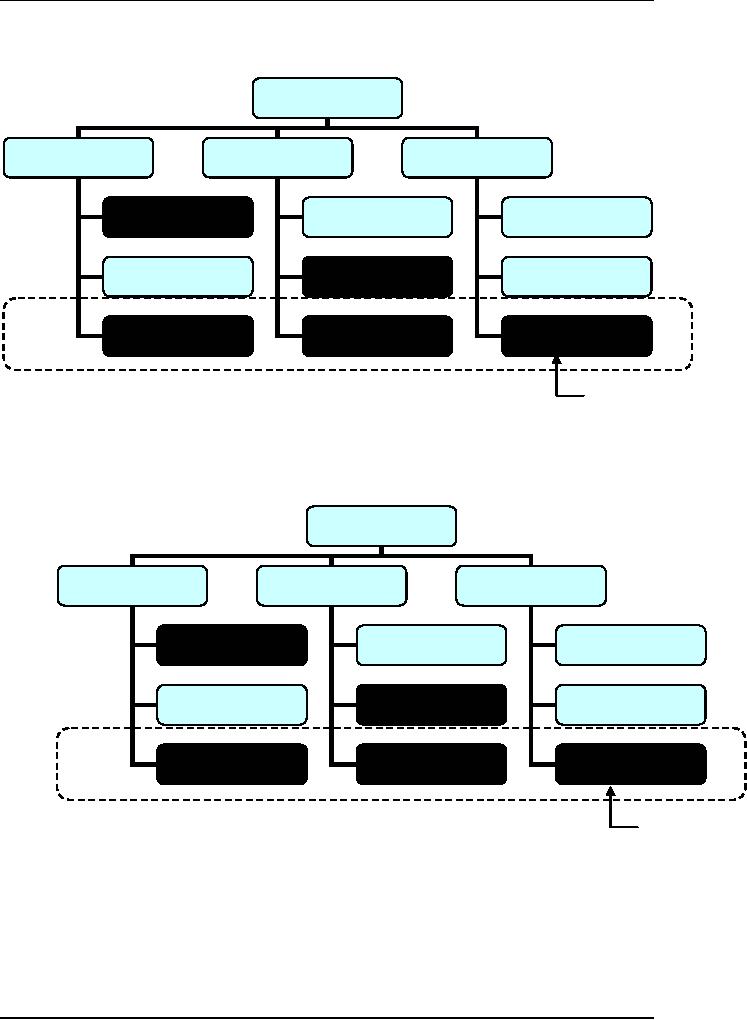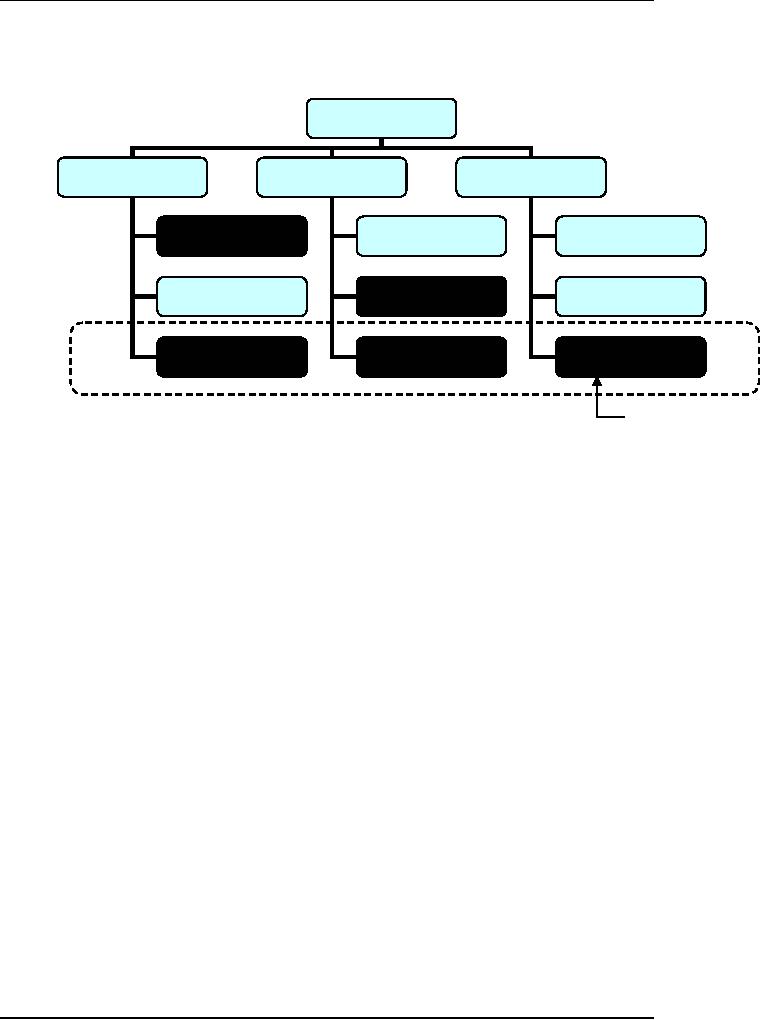 |
Organizational Systems |
| << Life cycle Models: Spiral Model, Statement of Requirement, Data Item Descriptions |
| ORGANIZATIONAL PLANNING, Organizational Management Tools >> |

Software
Project Management
(CS615)
LECTURE
# 27
5.
ORGANIZATION
5.1
Basic
Definition
Basically,
an organization is a group of people
intentionally organized to
accomplish
an overall, common goal or
set of goals. Business organizations
can
range in size
from two people to tens of
thousands.
How
you interpret each of the
above major parts of an organization
depends very
much on
your values and your nature.
People can view organizations as
machines,
organisms,
families, groups,
etc.
People
are managed through an
organizational structure. This
hierarchical
structure
is based on the four cornerstones of
management:
Delegation
Authority
Responsibility
Supervision.
Delegation
bestows authority, and authority produces
(and requires)
responsibility.
Both authority and responsibility
require supervision, and
effective
supervision
requires a suitable organizational
structure:
Most
projects are organized as
teams, with each team
assigned specific
functions
within
the project.
Different
types of project require
different types of team structure, as
for example
a team of
junior programmers requires a
technical team leader while a team
of
experts
may require only an
administrative team leader.
It is the
project manager's responsibility to
select the structure best
suited for the
project.
Basically
an organization is a group of people
intentionally organized to
accomplish
an overall, common goal or
set of goals. Business organizations
can
range in size
from two people to tens of
thousands.
How
you interpret each of the
above major parts of an organization
depends very
much on
your values and your nature.
People can view organizations as
machines,
organisms,
families, groups,
etc.
193

Software
Project Management
(CS615)
5.2
Organization
as a System
It helps
to think of organizations are
systems.
Simply
put, a system is an organized
collection of parts that are
highly integrated
in order
to accomplish an overall
goal.
The
system has various inputs
which are processed to
produce certain
outputs,
which
together, accomplish the
overall goal desired by the
organization.
There is
ongoing feedback among these
various parts to ensure they
remain
aligned
to accomplish the overall
goal of the organization.
There are several
classes
of systems, ranging from very
simple frameworks all the
way to social
systems,
which are the most
complex. Organizations are, of course,
social
systems.
Systems
have inputs, processes,
outputs and outcomes. To explain,
inputs to the
system
include resources such as
raw materials, money,
technologies and people.
These
inputs go through a process
where they're aligned, moved
along and
carefully
coordinated, ultimately to achieve
the goals set for the
system. Outputs
are
tangible results produced by
processes in the system,
such as products or
services
for consumers.
Another
kind of result is outcomes, or
benefits for consumers,
e.g., jobs for
workers,
enhanced quality of life for
customers, etc. Systems can be the
entire
organization,
or its departments, groups,
processes, etc.
Feedback
comes from, e.g., employees
who carry out processes in
the
organization,
customers/clients using the
products and services, etc.
Feedback
also comes from the larger
environment of the organization,
e.g.,
influences
from government, society,
economics, and technologies.
Each
organization has numerous subsystems, as
well. Each subsystem has its
own
boundaries
of sorts, and includes various
inputs, processes, outputs and
outcomes
geared to
accomplish an overall goal
for the subsystem.
Common
examples of subsystems are departments,
programs, projects, teams
and
processes
to produce products or services,
etc.
Organizations
are made up of people - who
are also systems of systems of
systems - and on it
goes. Subsystems are organized in a
hierarchy needed to
accomplish
the overall goal of the
overall system.
194

Software
Project Management
(CS615)
The
organizational system is defined
by, e.g., its legal
documents (articles of
incorporation,
by laws, roles of officers,
etc.), mission, goals and
strategies,
policies
and procedures, operating manuals,
etc.
The
organization is depicted by its
organizational charts, job
descriptions,
marketing
materials, etc.
The
organizational system is also maintained
or controlled by policies and
procedures, budgets,
information management systems, quality
management
systems,
performance review systems,
etc.
5.3
Structural
Dimensions
The
organization's structure, or design, is
the overall arrangement of
the
organization's
various roles, processes and
their relationships in the
organization.
The
design of an organization is a means to
accomplishing the
organization's
overall
goal - the structure is not
an end in itself.
In systems
theory terms, the design
ensures that the appropriate
inputs go through
the
necessary processes to produce
the required outputs to
produce the intended
outcomes.
Centralization
-the
extent to which functions
are dispersed in the
organization,
either in terms of integration
with other functions
or
geographically
Formalization
-
regarding the extent of
policies and procedures in the
organization
Hierarchy
-
regarding the extent and
configuration of levels in
the
structure
Routinization
-
regarding the extent that
organizational processes
are
standardized
Specialization
-
regarding
the extent to which
activities are
refined
Training
-
regarding the extent of
activities to equip
organization
members
with knowledge and skills to
carry out their
roles.
5.4
Organizational
Systems
Project-based
organizations are those
whose operations consist
primarily of
projects.
These organizations fall into
two categories:
Organizations
that derive their revenue
primarily from performing
projects for
others--architectural
firms, engineering firms,
consultants, construction
con-
tractors,
government contractors, nongovernmental
organizations, etc
Organizations
that have adopted management
by projects, these
organizations
195

Software
Project Management
(CS615)
tend to
have management systems in place to facilitate
project management.
For
example, their financial systems
are often specifically
designed for
accounting,
tracking, and reporting on multiple
simultaneous projects.
Non project-based
organizations often
lack management systems designed
to
support
project needs efficiently and
effectively.
The
absence of project-oriented systems
usually makes project
management more
difficult.
In some
cases, non project-based organizations
will have departments or other
subunits
that operate as project-based
organizations with systems to
match.
The
project management team should be acutely
aware of how the
organization's
systems
affect the project.
For
example, if the organization
rewards its functional
managers for charging
staff
time to projects, then the
project management team may need to
implement
controls
to ensure that assigned staff members
are being used effectively
on the
project.
5.5
Organizational
Cultures and Styles
Most
organizations have developed
unique and describable cultures.
These
cultures
are reflected in
their:
Shared
values,
Norms,
Beliefs
Expectations
Policies
and
Procedures
View
of authority relationships and numerous
other factors
Organizational
cultures often have a direct
influence on the
project.
A team
proposing an unusual or high-risk
approach is more likely to
secure
approval
in an aggressive or entrepreneurial
organization.
A project
manager with a highly participative
style is apt to encounter
problems
in a rigidly hierarchical organization,
while a project manager
with
an
authoritarian style will be equally
challenged in a participative
organization.
The
structure of the performing
organization often constrains
the availability of or
terms
under which resources become
available to the
project.
196

Software
Project Management
(CS615)
Organizational
structures can be characterized as
spanning a spectrum
from
functional
to projectized, with a variety of
matrix structures in
between.
The
following table shows key
project related characteristics of
the major types of
enterprise
organizational structures:
Table:
Organizational Structure Influences on
Projects
Project
Organization
Functional
Matrix
Projectized
Characteristics
Structure
Weak
Balanced
Strong
Little or
non
Limited
Low
to
Moderate
High
to
Project
Manager's Authority
Moderate
to
High
almost
Total
Virtually
Percent
of Performing
None
0-25%
15-60%
50-95%
85-100%
Organization's
Personnel assigned
Full
time to Project work
Part-time
Part
time
Full-time
Full-time
Full-time
Project
Manager's Role
Project
Project
Project
Project
Project
Common
Titles for Project
Manager/
Manager/
Manager/Pr
Coordinato
Coordinator/
Manager's
Role
Program
Program
oject
r/
Project
Project
Manager
Manager
Officer
Leader
Leader
Part-time
Part
time
Part-time
Full-time
Full-time
Project
Management
Administrative
Staff
5.6
Traditional
Structures of Business
Organization
i.
Functional
Structure
Most
business organizations start
out with a functional
structure, or a small
variation
of this structure. This is
the basic "building block"
for other structures.
In this
structure, there is a central
office which oversees
various departments or
major
functions, e.g., human resources,
finances, sales, marketing,
engineering,
etc.
Think of
a picture that has a box at
the top labeled "Central
Office". Think of a
row of
boxes underneath the top
box. Each box is labeled,
e.g., sales,
engineering,
human
resources, etc.
197

Software
Project Management
(CS615)
Connect
the boxes with lines coming
down from the top
box to each of the
boxes
below.
Use functional
structures when
the organization is small,
geographically
centralized,
and provides few goods and
services.
When
the organization experiences bottlenecks
in decision making and
difficulties
in coordination, it has outgrown
its functional
structure.
The
classic functional organization is a
hierarchy where each
employee has one
clear
superior. Staff members are
grouped by specialty, such as
production,
marketing,
engineering, and accounting at the
top level, with engineering
further
subdivided
into functional organizations
that support the business of
the larger
organization
(e.g., mechanical and
electrical).
Functional
organizations still have
projects, but the perceived
scope of the project
is
limited to the boundaries of
the function: the
engineering department in a
functional
organization will do its work
independent of the manufacturing
or
marketing
departments.
For
example, when a new product
development is undertaken in a
purely
functional
organization, the design phase is
often called a design
project and
includes
only engineering department
staff. If questions about
manufacturing
arise,
they are passed up the
hierarchy to the department
head, who consults
with
the
head of the manufacturing
department. The engineering
department head then
passes
the answer back down the
hierarchy to the engineering
project manager.
ii.
Projectized
Structure
In this
structure, there is a centralized
corporate office and under
it, are various
divisions
each of which is dedicated to
producing and / or selling a certain
type of
business
or product, e.g., product 1,
product 2, etc.
Each
division that is dedicated to a
certain business or product
is, in turn, is
organized
as its own functional
structure.
So,
for example, the division
dedicated to making product 1
has its own
sales
department,
human resources, etc. Basically,
project structure is a bunch
of
functional
structures each of which
reports to one central
office.
Use a
divisional structure when
the organization is relatively
large, geographically
dispersed,
and/or produces wide range of
goods/services.
In a
projectized organization, team members
are often collocated. Most
of the
organization's
resources are involved in
project work, and project
managers have
a great deal of
independence and authority.
198

Software
Project Management
(CS615)
Projectized
organizations often have
organizational units called
departments, but
these
groups either report
directly to the project manager or
provide support
services to
the various projects.
iii.
Matrix
Structure
Think of
the functional structure.
Imagine if you took someone
from each of the
major
functions in the functional
structure (the boxes along
the bottom of the
organization
chart), e.g., people from
sales, engineering, etc., and
organized them
into a
separate group intended to
produce and sell one certain
kind of product or
service.
Members
of this group stay together
until that product is
produced or they
continue
to sell and service it. This
overall structure (made up of a
functional
structure
that also has groups
assigned to products) is a matrix
structure.
This
structure is useful because it focuses
highly skilled people from
across the
organization
to work on a complex product or
service.
It can be
difficult, though, because
each person essentially reports to
two
supervisors:
the supervisor of the
functional area (e.g.,
engineering) and the
product
manager, as well.
When
the organization needs
constant coordination of its
functional activities,
then
lateral relations do not
provide sufficient integration.
Consider the matrix
structure.
To adopt
the matrix structure
effectively, the organization
should modify many
traditional
management practices.
Matrix
organizations are a blend of
functional and projectized
characteristics.
Weak
matrices maintain many of
the characteristics of a functional
organization,
and the
project manager role is more
that of a coordinator or expediter
than that of
a
manager.
In
similar fashion, strong
matrices have many of the
characteristics of the
projectized
organization--full-time project managers
with considerable authority
and
full-time project administrative
staff.
199

Software
Project Management
(CS615)
Chief
Executive
Functional
Functional
Functional
Manager
Manager
Manager
Staff
Staff
Staff
Staff
Staff
Staff
Staff
Staff
Staff
Project
Coordinatio
Figure
1:
Weak Matrix
Organization
Chief
Executive
Functional
Functional
Functional
Manager
Manager
Manager
Staff
Staff
Staff
Staff
Staff
Staff
Project
Manager
Staff
Staff
Project
Coordinatio
Figure
2: Balanced
Matrix Organization
200

Software
Project Management
(CS615)
Chief
Executive
Functional
Functional
Manager
of
Manager
Manager
Project
Managers
Project
Staff
Staff
Manager
Project
Staff
Staff
Manager
Staff
Staff
Project
Manager
Project
Coordinatio
Figure
3: Strong
Matrix Organization
(Black
boxes represent staff engaged in project
activites)
iv.
Project
Office
There is
a range of uses for what
constitutes a project office. A
project office may
operate
on a continuum from providing
support functions to project
managers in
the
form of training, software,
templates, etc. to actually
being responsible for
the
results
of the project.
Most
modern organizations involve
all these structures at
various levels. For
example,
even a fundamentally functional
organization may create a
special
project
team to handle a critical
project.
Such a
team may have many of the
characteristics of a project in a
projectized
organization.
The team
may include full-time staff
from different functional
departments, it
may
develop its own set of
operating procedures, and it may operate
outside the
standard,
formalized reporting
structure.
201
Table of Contents:
- Introduction & Fundamentals
- Goals of Project management
- Project Dimensions, Software Development Lifecycle
- Cost Management, Project vs. Program Management, Project Success
- Project Management’s nine Knowledge Areas
- Team leader, Project Organization, Organizational structure
- Project Execution Fundamentals Tracking
- Organizational Issues and Project Management
- Managing Processes: Project Plan, Managing Quality, Project Execution, Project Initiation
- Project Execution: Product Implementation, Project Closedown
- Problems in Software Projects, Process- related Problems
- Product-related Problems, Technology-related problems
- Requirements Management, Requirements analysis
- Requirements Elicitation for Software
- The Software Requirements Specification
- Attributes of Software Design, Key Features of Design
- Software Configuration Management Vs Software Maintenance
- Quality Assurance Management, Quality Factors
- Software Quality Assurance Activities
- Software Process, PM Process Groups, Links, PM Phase interactions
- Initiating Process: Inputs, Outputs, Tools and Techniques
- Planning Process Tasks, Executing Process Tasks, Controlling Process Tasks
- Project Planning Objectives, Primary Planning Steps
- Tools and Techniques for SDP, Outputs from SDP, SDP Execution
- PLANNING: Elements of SDP
- Life cycle Models: Spiral Model, Statement of Requirement, Data Item Descriptions
- Organizational Systems
- ORGANIZATIONAL PLANNING, Organizational Management Tools
- Estimation - Concepts
- Decomposition Techniques, Estimation – Tools
- Estimation – Tools
- Work Breakdown Structure
- WBS- A Mandatory Management Tool
- Characteristics of a High-Quality WBS
- Work Breakdown Structure (WBS)
- WBS- Major Steps, WBS Implementation, high level WBS tasks
- Schedule: Scheduling Fundamentals
- Scheduling Tools: GANTT CHARTS, PERT, CPM
- Risk and Change Management: Risk Management Concepts
- Risk & Change Management Concepts
- Risk Management Process
- Quality Concept, Producing quality software, Quality Control
- Managing Tasks in Microsoft Project 2000
- Commissioning & Migration